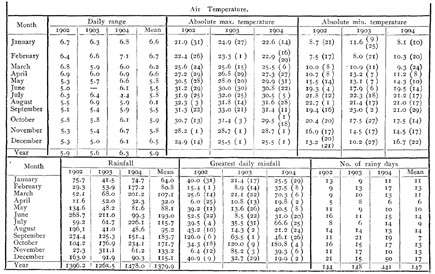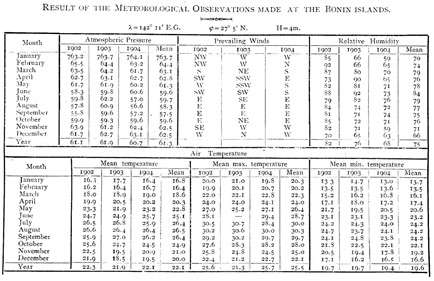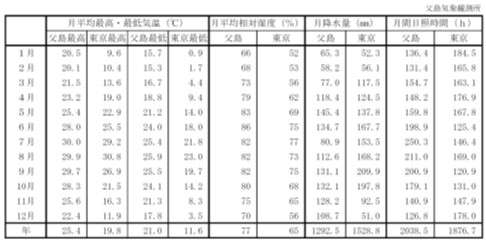In 1901, the first weather station of the Central Meteorological Observatory (CMO) (today the Japan Meteorological Agency) was built on Chichijima, and instruments such as thermometers, hygrometers, and rain gauges were installed. According to observations made over the three-year period from January 1902 to December 1904, the average temperature for the year was 22.1°C, with the highest temperature of 26.4°C being recorded in August, and the lowest temperature of 16.4°C in January. The annual temperature range was about 10°C, with very small diurnal temperature differences of around 6°C throughout the year. Rainfall was highest in June and September, and lowest in April and January. (Ref. 1)
Today, the Ogasawara Islands belong to a relatively warm subtropical climate zone, with hot and humid summer days. The islands are also characterized by small annual and daily variations in temperature and high humidity throughout the year. The average annual temperature in Chichijima for the period from 1981 to 2010 was 23.2°C, the average annual humidity was 77%, and the average annual precipitation was 1292.5 mm. Humidity is at its highest from May to October, with the monthly average humidity exceeding 80%. (Ref. 2)
Today, the Ogasawara Islands belong to a relatively warm subtropical climate zone, with hot and humid summer days. The islands are also characterized by small annual and daily variations in temperature and high humidity throughout the year. The average annual temperature in Chichijima for the period from 1981 to 2010 was 23.2°C, the average annual humidity was 77%, and the average annual precipitation was 1292.5 mm. Humidity is at its highest from May to October, with the monthly average humidity exceeding 80%. (Ref. 2)

Results of meteorological observations on Chichijima (1902-1904). (Ref. 1)
Results of meteorological observations on Chichijima (Monthly averages for 1981-2010). (Ref. 2)

Ref. 1: T. Okada, Notes on the climate of the Bonin islands. Okada Takematsu, “The climate of the Ogasawara Islands,” Journal of the Meteorological Society of Japan, 1st ed. 24 volumes, No. 6 (1905), pp. 19-23 [in English]
Ref. 2: Tokyo Metropolitan Ogasawara Branch Office, Kannai Gaiyo (Overview of the Jurisdiction), 2019 ed., pp.19-23.
Related documents
“Ogasawara gunto no kiko” (Climate of the Ogasawara Islands), Chigaku Zasshi (Journal of Geography). Vol. 17, 1905, pp. 602-603.


 RSS
RSS


Info Library
Japan's Island Territories
Senkaku Islands Facts & Figures
Takeshima Facts & Figures
Northern Territories Facts & Figures